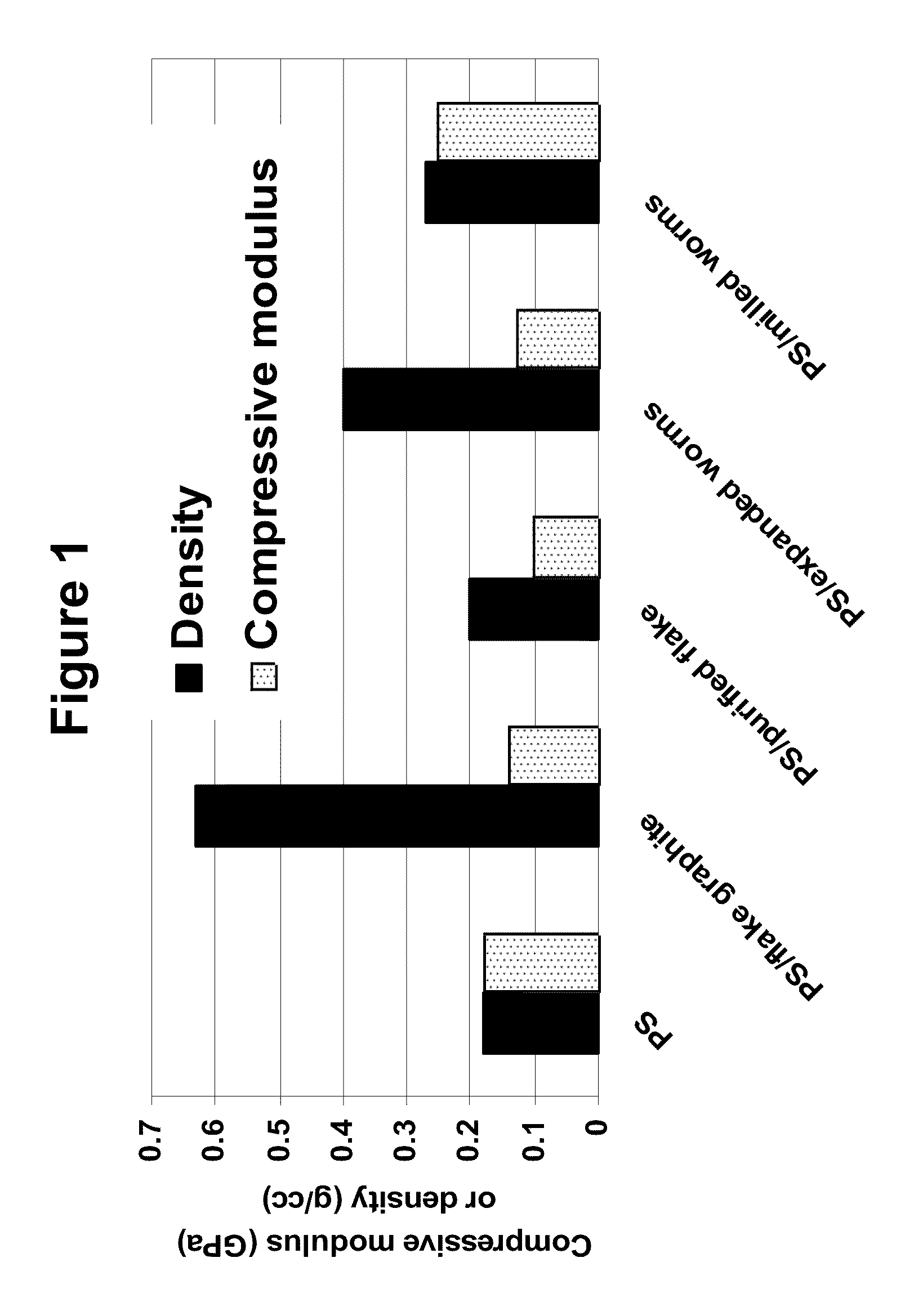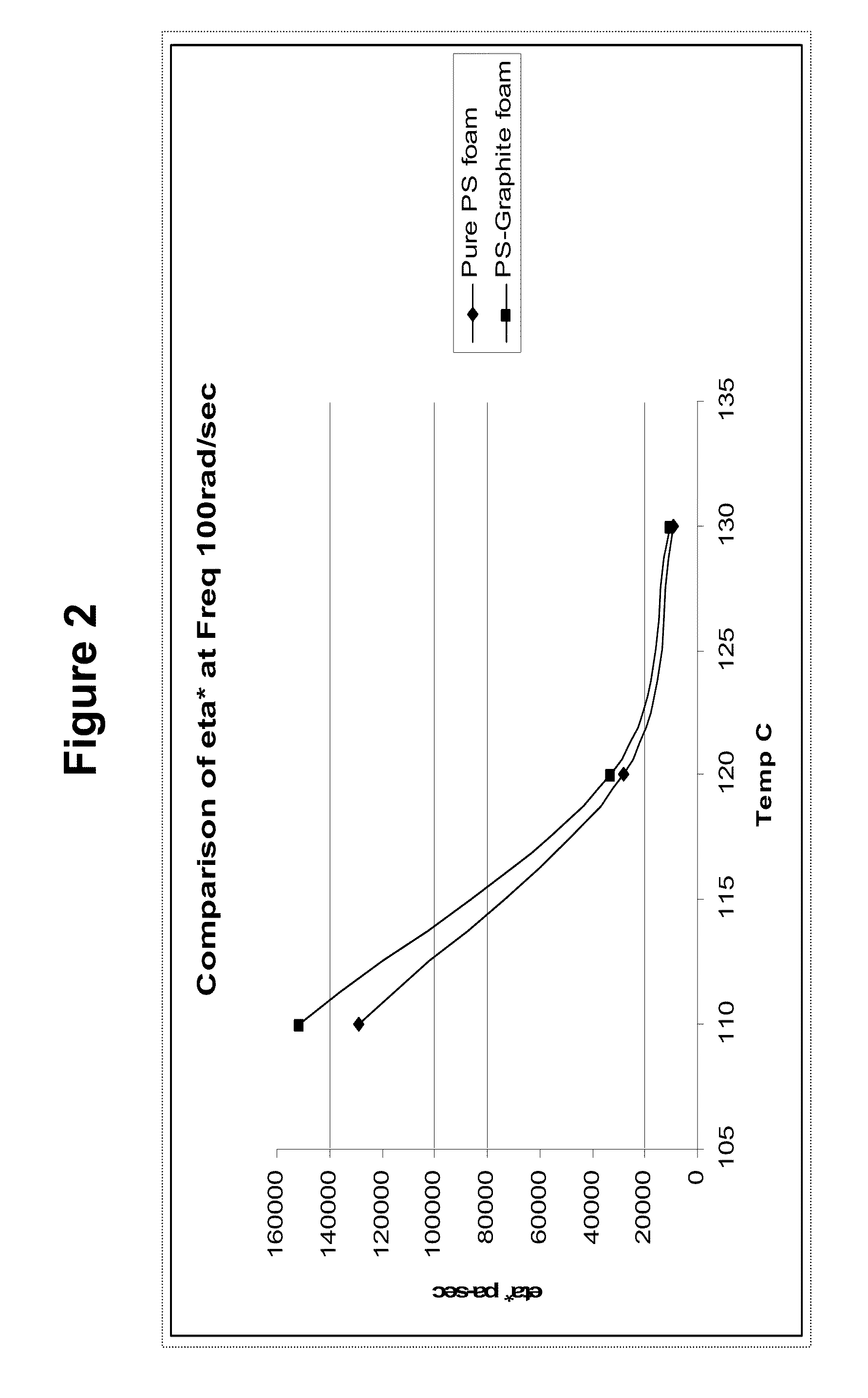Thermoplastic foams and method of forming them using nano-graphite
a technology of nanographite and thermoplastic foam, which is applied in the field of rigid foamed polymeric boards containing nanographite, can solve the problems of weakening the overall foam structure, difficult control of polymer foaming, and limited cell morphology control methods, so as to improve improve the effect of physical properties such as thermal insulation and compressive strength, and reduce the amount of static presen
- Summary
- Abstract
- Description
- Claims
- Application Information
AI Technical Summary
Benefits of technology
Problems solved by technology
Method used
Image
Examples
example 1
[0065]Polystyrene foams were prepared both with (7347) and without (7346) a 2.5% nano-particle loading using an LMP extruder. The nano-particle used to prepare this Example was an organoclay, specifically grade Nano-MMT 20A from Southern Clay Products Inc., that was melt compounded with a polystyrene polymer, specifically grade CX5197 from AtoFina, to form a melt polymer. The nano-particles exhibited an intercalated nano-MMT layer structure when examined using X-ray diffraction. The comparison sample did not include any nano-particles, but incorporated 0.8% talc loading as the nucleating agent. The comparison sample exhibited an average cell size of around 186 microns while the exemplary example utilizing the nano-particle foam exhibited a significantly reduced average cell size of around 60 microns. The exemplary example also exhibited a cell wall thickness of around 0.5 micron, and a strut effective diameter of around 5 microns. As reflected below in Table 2, the exemplary foam co...
example 2
[0066]Sample foams (7349) were produced according to the process outlined in Example 1, but using 0.5% of an intercalated nano-MMT in a polystyrene composition to produce an exemplary foam having a density of about 26.5 kg / m3, a thickness of about 38 mm and a width of about 600 mm. The reduction in the amount of nano-MMT incorporated into the composition resulted in a slightly increased cell size, about 83 microns (FIG. 8), compared with Example 1, while maintaining improved strength, 329 kPa, over the comparative foam compositions.
example 3
[0067]Foams (7790) were prepared using a nano-particle loading of 2% nano-calcium carbonate from Ampacet, along with 1% talc as an additional nucleating agent and 1% of stabilized hexabromocyclododecone as fire retardant agent in a LMP extruder. The nano-calcium carbonate particles were typically elongated, having average dimensions of 80 nm×2 μm, and were provided in a 50% master batch composition in combination with an olefinic copolymer carrier resin. The rest of formulation was polystyrene: 80% Nova 1220 (Melt Index=1.45) and 16% Nova 3900 (Melt Index=34.5). The exemplary foam produced was 28 mm thick, 400 mm wide and had an average cell size of 230 microns with a cell orientation—the ratio of the cell dimension in the extrusion direction to the cell dimension in the thickness direction (x / z)—as high as 1.54 (see FIG. 9).
PUM
| Property | Measurement | Unit |
|---|---|---|
| size | aaaaa | aaaaa |
| thickness | aaaaa | aaaaa |
| mean cell size | aaaaa | aaaaa |
Abstract
Description
Claims
Application Information
 Login to View More
Login to View More - R&D
- Intellectual Property
- Life Sciences
- Materials
- Tech Scout
- Unparalleled Data Quality
- Higher Quality Content
- 60% Fewer Hallucinations
Browse by: Latest US Patents, China's latest patents, Technical Efficacy Thesaurus, Application Domain, Technology Topic, Popular Technical Reports.
© 2025 PatSnap. All rights reserved.Legal|Privacy policy|Modern Slavery Act Transparency Statement|Sitemap|About US| Contact US: help@patsnap.com



